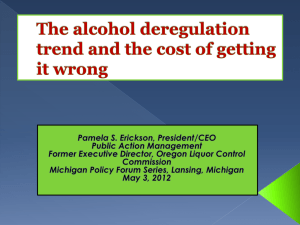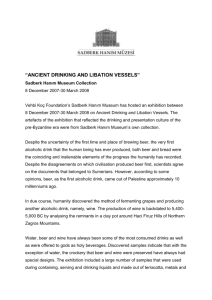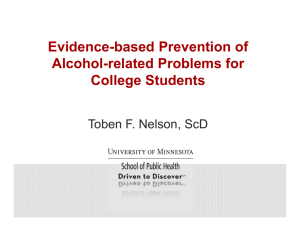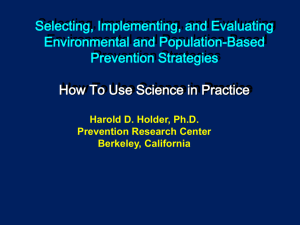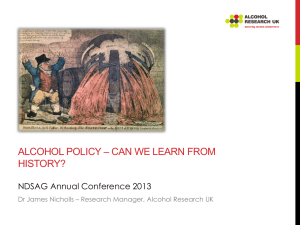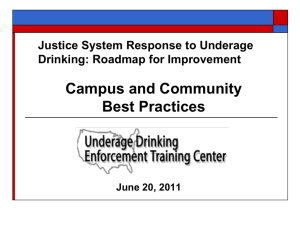The Important Role of Tied House Laws in Today`s Market
advertisement
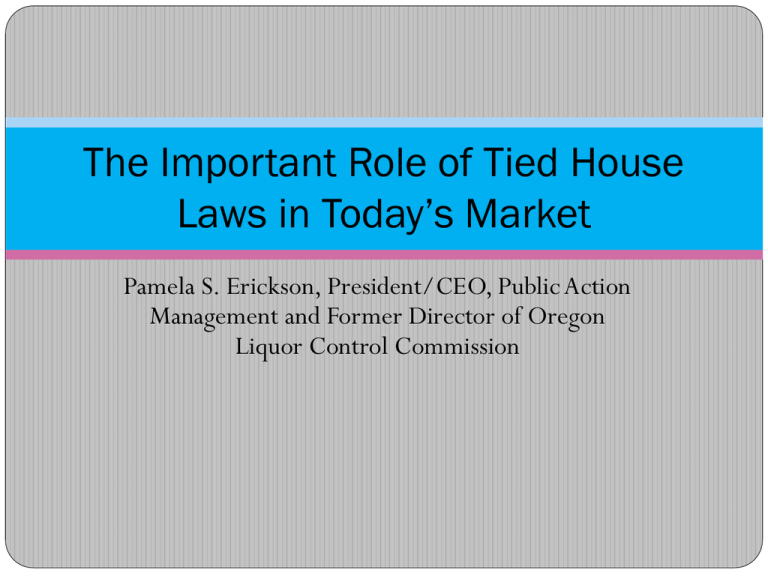
The Important Role of Tied House Laws in Today’s Market Pamela S. Erickson, President/CEO, Public Action Management and Former Director of Oregon Liquor Control Commission Free markets bring large quantities of cheap alcohol with heavy promotion But…aren’t lower prices a good thing? • Since the recession, people expect and value low prices. • But, alcohol is different: – Lower prices increase consumption. – Lower prices often require high volume purchase. – Continued low prices will eventually lead to serious social problems. Alexander C. Wagenaar, PhD, University of Florida College of Medicine. “Our meta-analysis cumulated information from all the published scientific research on this topic over the past half century, and results clearly show increasing the price of alcohol will result in significant reductions in many of the undesirable outcomes associated with drinking." Look what happened in the retail sector before Prohibition: prohibition: The Alcohol Scene: Alcohol sold primarily in “Tied House” saloons. Most common drink was beer, sold in glasses, kegs and buckets. Aggressive sales promoted high volume drinking. Social problems: public disorder, intoxication and addiction, family wages squandered, prostitution, gambling. Saloon System: Large, out of state, manufacturers own many retail outlets How do free markets lead to problems? • Domination: Markets evolve toward a few, large players, e.g. Intel, Home Depot. • Fierce price competition: price wars, loss leaders, discounts for volume consumption. Small, local operators are undercut and out of business. • Community norms are ineffective: National or foreign corporations are hard to constrain. • Weakened regulation: Large corporations with major legal and lobbying budgets advocate for deregulation and regulatory agency cuts. Today’s market problem: Supermarkets high volume, low prices Net profit for food retailers is less than two pennies on each dollar of food sales. How can supermarkets survive? “To earn a dollar, supermarkets would rather sell a $1 item 100 times, making a penny on each sale, than 10 times with a dime markup.” Source: Food Marketing Institute (Advocacy group for supermarkets) What grocery chains need for their “mass merchandising” business model model Large chain with many “big box” stores. Warehouse and distribution system. Ability to buy directly from manufacturer. Ability to buy at discount, sell high volume, freely advertise, and offer promotional incentives. Availability. Allows alcohol to be sold by the bottle and the drink, but limits the number, location, types of alcohol products, and hours of outlets. No “Bargain Booze”. Regulations balance prices, control price competition, and restrict dangerous marketing and promotional practices. Children and Teens. Age restrictions protect young people from the serious problems of underage drinking. Drunk driving. Creates and enforces strict measures against drinking and driving—sobriety checks, blood alcohol limits, driver’s license suspension. Education and Enforcement. Uses the carrot of education (alcohol awareness programs, “schools” for offenders) and the stick of enforcement (fines, community service and jail) when education fails. Source: Adapted from World Health Organization recommendations. State regulatory systems meet the ABC’s, but they are endangered We’ve forgotten why we have alcohol regulation “Free market” advocates cry for deregulation In 1933, state alcohol marketplaces designed to prevent problems experienced before Prohibition Objectives: Methods: Separate manufacturer from retailer to prevent market domination by vertical integration. Wholesaler is a “buffer.” Eliminate sales tactics that promote intoxication, violence and other problems. Promote “lighter beverages”, i.e. lower alcohol content (usually 3.2% beer); sell beer in single-serving containers v. kegs or buckets. Allow for modification of regulations to meet changing conditions. • Reduce economic and political influence of large alcohol companies. • Reduce public disorder, violence and other social problems. • Promote moderation for those that drink. • Gain public acceptance; eliminate lawlessness. Three Tiered System supplier wholesaler retailer Financial Independence prevents business practices which promote increased and high volume consumption through price reductions. (Ownership prohibited between sectors) Functional Independence protects the integrity of the three-tiered system by prohibiting ways to circumvent it. (One sector can’t perform function of another) Price Regulations prevent increased consumption that would occur by selling large quantities of very cheap product. (Uniform pricing, ban on volume discounts) Promotion and Advertising Regulations prevent business practices that target high drinking groups and promote volume consumption. Tax Collection provides for an efficient tax collection system. Product Tracking prevents sale of tainted and counterfeit product. Age Restrictions prevent sales to underage youth. Availability Limits reduce consumption, social problems and burden on law enforcement. Retail system fosters moderation What to do about current threats? Threats Lawsuits--Retailers and manufacturers challenge marketplace regulations. Since 2005, over half the states have been sued in federal court. • Legislation--Retailers challenge regulations: sell all categories of alcohol; more locations; extension of hours and days of sale; eliminate tiered system; eliminate advertising and promotion curbs. • Ballot measures--Large corporations finance ballot measure signature gathering and campaigns. • Budget reductions--prevent regular enforcement. • Actions 1. Support Congressional efforts to reaffirms state’s primary authority to regulate alcohol such as the CARE Act. 2. Educate policy makers about the effectiveness of regulation. Understand the difference between education and lobbying. 3. Reach out to public health, prevention advocates and others to work together on these issues. For more information contact: Pamela Erickson, www.pamaction.com www.healthyalcoholmarket.com for Healthy Alcohol Marketplace newsletter and resource material
